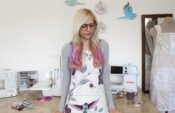“All that I am or hope to be, I owe to my mother” -Abraham Lincoln
May is the month where many of us around the world celebrate our mothers.
Growing up my mom made many of my clothes. When I was very young and until age 7, we lived in Swaziland & Botswana where clothing shops were limited. I would draw and describe what clothes I wanted and my mom would sew them for me!
As soon as I was old enough, my mom taught me to sew and 2 years ago she bought me my Bernina sewing machine (a Virtuosa 160 bought 2nd hand in fantastic condition from a family friend.)
She also introduced me to second hand clothing shops and showed me how to alter and personalise my clothes.
While attending high school my parents gave me the opportunity to study fashion design at a night college. Even though the college wasn’t the closest, my mom would drive me to and from these evening lessons.
All the skills and opportunities my mom afforded me have allowed me to do what I love today.
I love that I can discuss sewing techniques and ideas with her and that she is always ready to help.
Zero-waste Fashion
On average, 15% of the total fabric used in the fashion industry is wasted, adding to many the negative impacts of fashion on Mother Nature. The idea of a zero-waste pattern was developed to counteract this wasteful practice. The challenge is to create a pattern that leaves little to no offcuts or scraps. One has to think outside of traditional pattern drafting techniques. There is no one way to draft a zero-waste pattern, as long as a desirable garment is reached in the end and no fabric is wasted, then you have done a great job! Here is an article about Zero-waste that features a garment I made as part of the Live Eco Remake Challenge:
Here is an article about Zero-waste that features a garment I made as part of the Live Eco Remake Challenge:
Why does Zero-waste Fashion matter?
My Zero-waste Pattern
 This is a very basic zero-waste pattern that I drafted. There are many complicated patterns that some very creative people have drafted but zero-waste patterns don’t have to be so complicated.
This is a very basic zero-waste pattern that I drafted. There are many complicated patterns that some very creative people have drafted but zero-waste patterns don’t have to be so complicated.
Out of 3,5 metres of fabric I got an A-line skirt, a bodice/sleeves and a waistband/tie.
As I originally made this dress for a friend’s music video, we kept the full width of the fabric (1.5m) for the length of the skirt for dramatic effect. I could re-arrange the pattern pieces to make a shorter dress with less fabric.
How I made my Zero-waste dress
- To start, I edged the sleeve pieces with the 3-thread rolled hem stitch.
I left one of the long edges of each sleeve raw.
I try to avoid creating waste by cutting off any fabric while overlocking but rather just trim the frayed bits.
- Using the 3-thread flat stitch, I overlocked the remaining raw edge. This edge will form the neckline.

- Continuing with the flat stitch, I joined both side seams of the skirt and edged the centre back seam.

- I placed the sleeves on my mannequin in order to see how low to make the neckline.

- Using my sewing machine, I sewed an open seam.
I then folded the overlocked edge away and top-stitched it in place along the whole edge of the neckline, creating a rolled hem.
- After joining the tie waistband together to make 1 long tie, I then joined it lengthwise and made a tube with an opening in the middle. This will be where the bodice and skirt join the waistband.

- I sewed the centre back seam of the skirt, leaving an opening at the top. Usually one would insert a zip in this opening but I decided to neaten the edge with a sewn rolled hem and leave it open. As the garment is transparent, one will need to wear an undergarment so a zip for modesty isn’t necessary.

- I joined the skirt and the front of the bodice to the opening in the waistband.

- I secured the sleeves at the back to the waistband with a small row of stitches at the centre back seam.

- Using the 3-thread rolled hem stitch, I overlocked the hem of the dress.

- To prevent the sleeves from falling off the shoulders, I plaited some embroidery thread and hand-stitched it in place.
I would love to see your zero-waste creations, please feel free to share them with me!
Instagram
Facebook
I hope all the moms out there felt extra special this month.
-Hannah-Rose
All patterns designed by me are for personal use only.
 BERNINA Corporate Blog -
BERNINA Corporate Blog -








What a great idea to cut the pattern, starting from the ‘no-waste’ idea! Go on with this and be aware of the impact of what we do on environment!
Thank you Bea!
I hope this post inspired you 😉
I’ve got a few ideas of other ways to use this simple zero-waste pattern with some thrifted/second-hand fabrics.
I hope others can see that there are some basic environmentally-friendly choices one can make when making clothes.